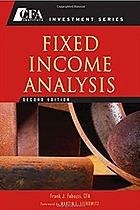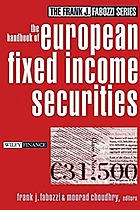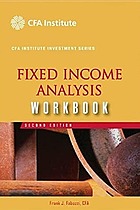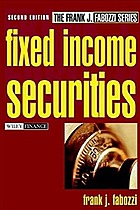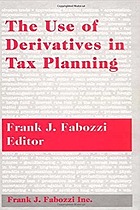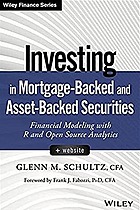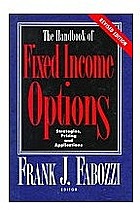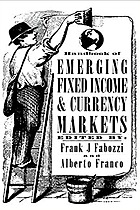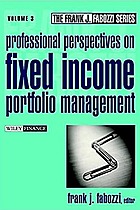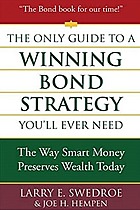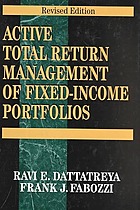
Fixed Income
Fixed income broadly refers to those types of investment security that pay investors fixed interest or dividend payments until their maturity date. Fixed income investments, or bonds as they are commonly known, typically provide a premium above inflation and experience less return volatility compared with shares. These investments are designed to generate a specific level of interest income, while also providing diversification, capital preservation, and potential tax exemptions. While stocks get headlines, fixed income is a more low-key source of cash flow and capital preservation. Often, when stocks are declining in value, fixed income is gaining in value, making them an important hedge. Other common asset classes include equities (e.g., stocks), cash and equivalents, real estate, commodities, and currencies.
Experts - People
Aaron Brown
Aaron Hodari
Aaron Kaplan
Aaron Uitenbroek
Adam Cohen
Adam O'Dell
Adrian Helfert
Alan Greenspan
Alan Gula
Alan Higgins
Albert Yeh
Alberto Gallo
Alex Bryan
Alex Gurevich
Alex Hoeptner
Alex Lennard
Alex Lieberman
Alfonso Peccatiello
Ali Hassan
Allison Schrager
Amanda Agati
Amanda Tepper
Amelia Bourdeau
Amlan Roy
Amy Hong
Amy Oldenburg
Amy Raskin
Andreas Clenow
Andreas Steno Larsen
Andrew Feldstein
Andrew Park
Andrew Saunders
Andrew Schneider
Andrew Schultz
Andy Edstrom
Andy Hecht
Angelo Manioudakis
Angelo Robles
Angus Shillington
Aniket Ullal
Anil Lulla
Anne Richards
Anneka Treon
Anthony Scaramucci
Anton LeRoy
Ari Paul
Arik Ben Dor
Art Hogan
Arthur Hyde
Aryeh Bourkoff
Asoka Woehrmann
Austin Campbell
Austin Root
Barney Mannerings
Barry Knapp
Bart Melek
Ben Breitholtz
Ben Chrnelich
Ben Hunt
Ben Melkman
Ben Powell
Ben Tisch
Benjamin Halliburton
Benoit Bosc
Beth Hammack
Bilal Hafeez
Bill Blain
Bill Campbell
Bill Demchak
Bill Gross
Bill Gurtin
Bill Kaye
Bill Poulos
Bo Zhang
Bob Elliott
Bob Johnson
Bob Kunimura
Bob Lang
Bob Treue
Bobby Jain
Brad Levy
Bradley Duke
Brendan Ahern
Brent Donnelly
Brett Caughran
Brett Tejpaul
Brian Kelly
Brian Levitt
Brian McCarthy
Brian Nelson
Brian Portnoy
Brian Shannon
Brian Weinstein
Brian Werdesheim
Brooker Belcourt
Bruce Mumford
Bruce Munster
Bruce Phelps
Bruce Richards
Bruno Pannetier
Bryan Campbell
Callum Thomas
Cameron Hight
Carley Garner
Carter Malloy
Cathie Wood
Cem Karsan
Chad Morganlander
Chaim Siegel
Charles Biderman
Charles Sizemore
Charles Tall
Charlie McGarraugh
Charlie Morris
Chen Zhao
Chiente Hsu
Chris Aitken
Chris Alexander
Chris Bailey
Chris Berry
Chris Blasi
Chris Castroviejo
Chris Cole
Chris DeMuth Jr
Chris Eddy
Chris Hohlstein
Chris Joye
Chris Olsen
Chris Pavese
Chris Perkins
Chris Vermeulen
Chris Whalen
Christophe Ollari
Clark Fenton
Cormac Kinney
Corvin Codirla
Courtney Smith
Crista Huff
Dan Barclay
Dan Greenhaus
Dan Jerrett
Dan Morehead
Dan Passarelli
Dan Rasmussen
Dan Zwirn
Dana Stewardson
Daniel Lacalle
Daniel Strachman
Danielle Booth
Darius Dale
Dave Breazzano
Dave Descalzi
Dave Donnelly
Dave Mazza
David Berns
David Dorr
David Dredge
David Duong
David Hunt
David Keller
David Kotok
David Magrone
David Merkel
David Modiano
David Nage
David Namdar
David Packham
David Shimko
David Tepper
David Trainer
David Woo
David Zervos
Davis Edwards
Dean Curnutt
Dean Trindle
Debashish Bose
Diana Choyleva
Diana Joseph
Diego Parrilla
Divya Narendra
Dominique Dwor-Frécaut
Don d'Adesky
Donald van Deventer
Doug Kinsey
Doug MacKay
Douglas Borthwick
Douglas Lucas
Drew Zager
Drew Bradford
Drianne Benner
Dwight Emanuelson
Dylan Grice
Ed Dowd
Ed Yardeni
Edward McQuarrie
Edwin Elton
Ehren Stanhope
Eiad Asbahi
Eileen Murray
Elaine Meyers
Eli Rauch
Elliott Allswang
Emad Mostaque
Emma Giamartino
Eric Crittenden
Eric Henderson
Eric Peters
Eric Wallerstein
Euan Sinclair
Evan Lorenz
Fotios Piniros
Francis Hunt
Frank Burke
Frank Fabozzi
Frank Holmes
Frank Partnoy
Frank Reilly
Fredrik Nerbrand
Galen Burghardt
Gareth Murphy
Gareth Soloway
Garrett Goggin
Gary Antonacci
Gavin von Loeser
Genevieve Roch-Decter
Geo Chen
Geoff Marcus
Geoffrey Webster
George Clark
George Goncalves
George Saravelos
Gerald Jensen
Gina Sanchez
Giuseppe Paleologo
Glen Strauss
Glenn Degenaars
Gontran de Quillacq
Grace Rodriguez
Greg Diamond
Greg Foss
Greg Obenshain
Greg Onken
Greg Reid
Greg Vaughan
Greg Weldon
Guillermo Dumrauf
Guy Cerundolo
Guy Keller
Hans Humes
Hari Krishnan
Harley Bassman
Harry Melandri
Heather Brilliant
Hector Fernandez
Henry Ma
Hildy Richelson
Howard Penney
Howard Wang
Hugo Philion
Ira Walker
JC Parets
JG Savoldi
JM Mognetti
Jack Inglis
Jake Weber
James Butterfill
James Dondero
James Ferguson
James Helliwell
James Lavish
James Medeiros
Jamie Coutts
Jamil Baz
Jan van Eck
Jared Bibler
Jared Dillian
Jason Dworak
Jason Hsu
Jason Moser
Jason Pagoulatos
Jason Raznick
Jawad Mian
Jay Canell
Jay Pelosky
Jay Soloff
Jeannine Vanian
Jeff Dorman
Jeff Fischer
Jeff Gundlach
Jeff Horowitz
Jeff Kilburg
Jeff Kobernick
Jeff Marcus
Jeff Megar
Jeff Miller
Jeff Mills
Jeff Moore
Jeff Park
Jeff Schulze
Jeff Weiss
Jeff Zirlin
Jeffrey Mettel
Jenny Harrington
Jens Nordvig
Jeremy LaKosh
Jeremy Schwartz
Jerry Hwang
Jim Bianco
Jim Grant
Jim Masturzo
Jim Muzzy
Jim Puplava
Joanna Zeng
Joe Cavatoni
Joe Karas
Joe McAlinden
Joel Litman
John Bowman
John Ciampaglia
John Kiple
John Kosar
John Mousseau
John Murphy
John Palmer
John Rutledge
Jon Eilbeck
Jon Mawby
Jonas Thulin
Jonathan Beukelman
Jonathan Krane
Jonathan Treussard
Jordan Kotick
Jordan Waxman
Jordi Visser
Joseph Amato
Josh Gully
Josh Malkin
Josh Rosner
Julian Brigden
Julien Bittel
Juliette Declercq
Juliette Menga
Jurrien Timmer
Justin Saslaw
Jérôme Stern
Kamil Liberadzki
Kara Murphy
Karen Finerman
Karl Dasher
Kathy Jones
Keith Brown
Keith Dicker
Keith Rosenbloom
Kelley Wright
Kenny Polcari
Kent Collier
Keri Findley
Kevin Coldiron
Kimberly Flynn
Kinjal Amin
Kokou Agbo-Bloua
Komal Sri-Kumar
Kori Hale
Kristina Hooper
Lacy Hunt
Laila Kollmorgen
Lance Roberts
Larry McDonald
Larry Raffone
Larry Robbins
Larry Swedroe
Lars Seier Christensen
Lawrence Lewitinn
Lee Robinson
Leland Clemons
Leo Kolivakis
Leo LiVolsi
Leo Mizuhara
Leon Gaudiosi
Lester Brafman
Lev Dynkin
Lex van Dam
Liz Ann Sonders
Liz Young
Lloyd Khaner
Luis Garcia-Feijoo
Luke Ellis
Luuk Strijers
Lyle LaMothe
Lyle Wolberg
Magdalena Polan
Maleeha Bengali
Marc Chandler
Marc Cohen
Marc Gerstein
Marc Mayer
Marcelo Lopez
Marcos Carreira
Marcos Douer
Margret Trilli
Maria Smirnova
Mario Oliviero
Mark Carney
Mark Cortazzo
Mark Cullen
Mark Douglass
Mark Dow
Mark Sebastian
Mark Shenkman
Mark Versey
Mark Whitmore
Mark Woolley
Marko Kolanovic
Markus Heitkoetter
Martin Gruber
Martin Leibowitz
Martin Leinweber
Martin Pelletier
Marty Fridson
Marvin Barth
Mary Callahan Erdoes
Matt Dillig
Matt Peron
Matt Tucker
Matt Zames
Matteo Perruccio
Matthew Byer
Matthew Graham
Matthew Waz
Matthias Knab
Max Galka
Maziar Minovi
Meb Faber
Michael Ashton
Michael Barrington-Hibbert
Michael Boyd
Michael Covel
Michael Craig-Scheckman
Michael Every
Michael Gayed
Michael Hintze
Michael Howell
Michael Kahn
Michael Kao
Michael Kramer
Michael Lebowitz
Michael Livian
Michael Nicoletos
Michael Petley
Michael Pettis
Michael Pusateri
Michael Rubenstein
Michael Sonnenshein
Michelle Noyes
Mick McLaughlin
Mikael Sarwe
Mike Abrams
Mike Cagney
Mike Cahill
Mike Creadon
Mike Drury
Mike Gallagher
Mike Green
Mike Heroux
Mike Kantrowitz
Mike Reed
Mike Ricca
Mike Robinson
Mike Simcock
Mike Taylor
Mish Schneider
Mish Shedlock
Moe Zulfiqar
Moez Kassam
Mona El Isa
Moss Crosby
Mustafa Chowdhury
Nancy Davis
Neal Berger
Neil Canell
Neil Dutta
Neil George
Neil Schofield
Nelly Nyambi
Nick Hammer
Nick Lawson
Noel Weil
Noreen Beaman
Osman Ozsan
Pablo Calderini
Patrick Boyle
Paul Isaac
Paul Kim
Paul Mampilly
Paul McNamara
Paul Viera
Paul Zemsky
Pei Chen
Pete Briger
Peter Albano
Peter Berezin
Peter Bermont
Peter Boockvar
Peter Brandt
Peter Churchouse
Peter Goodburn
Peter Lacalamita
Peter Seilern
Peter Tchir
Philip Fischer
Philippe Khuong-Huu
Pippa Malmgren
Prateek Mehrotra
Preston McSwain
R. Martin Chavez
Ram Ahluwalia
Ramsey Smith
Raoul Pal
Ray Nolte
Ray Uy
Rayne Steinberg
Rich Apostolik
Rich Pluta
Rich Saperstein
Richard Bernstein
Richard Brostowicz Jr.
Richard Kim
Richard Lehmann
Richard Sandor
Richard Teng
Richard Zinman
Rick Rieder
Rishi Narang
Rob Davis
Rob Kapito
Rob Shafir
Rob Sharps
Robert Balan
Robert Doty
Robert Grunewald
Robert Levine
Roberto Sallouti
Robin Fink
Ronnie Stoeferle
Roxton McNeal
Rudy Martin
Russ Brownback
Russel Kinnel
Russell Napier
Ryan Ripp
Saagar Gupta
Sabrina Fox
Sahm Adrangi
Said Haidar
Saker Nusseibeh
Sam Burns
Samuel Rines
Sandra Kartt
Sarah Gefter
Sarat Sethi
Scott Siegel
Scott Acheychek
Scott Army
Scott MacKillop
Scott Skyrm
Scott Slayton
Scott Stackman
Scott Wood
Sebastien Page
Serge Berger
Sergio Silva
Sethu Bijumalla
Shannon Saccocia
Shawn Fowler
Shirl Penney
Shundrawn Thomas
Siddhartha Jha
Simon Fine
Simon Ree
Slobodan Jovanovic
Srinivas Thiruvadanthai
Stefan Kreuzkamp
Stephanie Link
Stephanie Ruhle
Stephen Antczak
Stephen Castellano
Stephen Lee
Stephen Miran
Stephen Paras
Stephen Weiss
Steve Hanke
Steve Hollomon
Steve Hou
Steve Kaczmarek
Steve Kurz
Steve Miley
Steven Bavaria
Steven Bleiberg
Steven Goldstein
Steven Hawkins
Steven McClurg
Steven Schoenfeld
Sudhu Arumugam
Sven Miserey
Sylvain Raynes
Tad Rivelle
Taimur Baig
Tariq Dennison
Ted Seides
Terrence Belton
Terri Jacobsen
Thejas Nalval
Theodore Barnhill
Thomas Braziel
Thomas Riegert
Tim Maloney
Tim Seymour
Todd Battaglia
Todd Edgar
Todd Harrison
Todd Silaika
Tom Caddick
Tom Farley
Tom Frame
Tom Gahan
Tom Lee
Tom Moran
Tom Trowbridge
Tommy McBride
Tony Crescenzi
Tony Greer
Tony Mackenzie
Tony Pasquariello
Tony Saliba
Tony Zhang
Tracy Maitland
Trevor Mottl
Tristan Lewis
Troy Thornton
Vicki Bryan
Victor Livingstone
Viktor Shvets
Vince DiLullo
Vince Sarullo
Vincent Catalano
Vincent Randazzo
Vineer Bhansali
Vishal Reddy
Vitaliy Katsenelson
Warren Pies
Will Braman
Will Rhind
Woody Bradford
Woody Brock
Xavier Rolet
Yan Liberman
Yannik Zufferey
Zach Scheidt
Zed Francis
KEY NOTES
Government and corporate bonds are the most common types of fixed-income products.
For most investors, stocks and bonds go together like peanut butter and jelly. They’re the two main pillars of a well-balanced portfolio, the key ingredients in your long-term wealth.
Many people shift their portfolios toward a fixed-income approach as they near retirement, since they may need to rely on their investments for regular income.
TYPES OF FIXED INCOME PRODUCTS
Treasury Bills (T-bills). Short-term fixed-income securities that mature within one year that do not pay coupon returns. Investors buy the bill at a price less than its face value and investors earn that difference at maturity.
Treasury Notes (T-notes). Come in maturities between two and 10 years, pay a fixed interest rate, and are sold in multiples of $100. At the end of maturity, investors are repaid the principal but earn semiannual interest payments until maturity.
Treasury Bonds (T-bonds). Similar to the T-note except that it matures in 20 or 30 years. Treasury bonds can be purchased in multiples of $100.
Treasury inflation-protected securities (TIPS). Protect investors from inflation. The principal amount of a TIPS bond adjusts with inflation and deflation.
Municipal Bonds. Commonly called munis, state governments, municipalities or other governmental agencies issue this form of fixed income. Muni bonds can have tax-free benefits to investors as well.
Corporate Bonds. Corporations sell these types of fixed income securities. The yield typically depends in part on the creditworthiness of the issuer. The higher the credit rating, the lower the coupon rate.
High yield Bonds. Also known as junk bonds, these securities are typically issued with higher coupon rates than investment-grade bonds due to lower credit ratings and greater risks of default.
Certificate of Deposit (CD). A fixed income vehicle offered by financial institutions with maturities of less than five years.
FIXED INCOME ADVANTAGES
Diversification. Investors never want to have their eggs in one basket. It is true that stocks tend to beat bonds over the long haul, but you’re better off moderating your risk, especially in the near term.
Income Generation. Due to the fixed coupon payments that investors receive at specified intervals, bonds can provide a steady and predictable flow of income.
Corporate Preservation. Bonds make sense for money that you’ll need in five–to–10 years, an important consideration for retirees who are more sensitive to portfolio volatility as they have less time to recoup losses.
FIXED INCOME RISKS
Interest Rate Risks. Fixed income securities are very sensitive to changes in interest rates. When rates rise, bond prices fall. Conversely, when rates fall, prices rise.
Inflation Risks. Bonds provide a regular income stream, but the purchasing power of this income can deteriorate when inflation rises.
Credit Risk. Credit risk is the extent to which a company might be likely to default, in which case the bondholder could lose some, or all, of their principal.
Liquidity Risks. This is the risk that a bondholder may be unable to sell a fixed income security due to a lack of buyers. In an illiquid market, an investor may be forced to sell at a lower price than they paid for the investment.
























































































































































































































































































































































































































































































































































































































































































































